height CHEVROLET TRACKER 1998 1.G Owners Manual
[x] Cancel search | Manufacturer: CHEVROLET, Model Year: 1998, Model line: TRACKER, Model: CHEVROLET TRACKER 1998 1.GPages: 386, PDF Size: 21.17 MB
Page 38 of 386
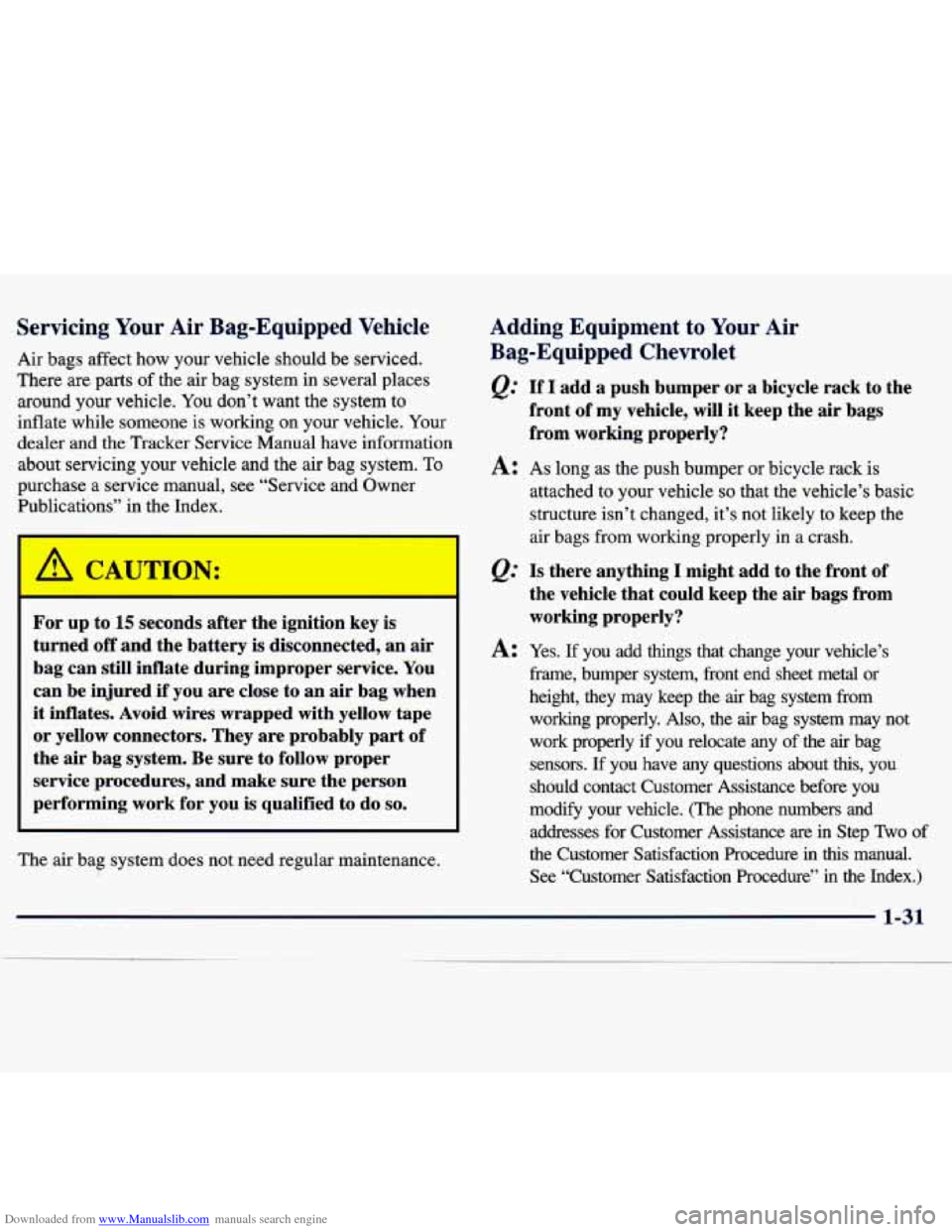
Downloaded from www.Manualslib.com manuals search engine Servicing Your Air Bag-Equipped Vehicle
Air bags affect how your vehicle should be serviced.
There are parts of the air bag system in several places
around
your vehicle. You don’t want the system to
inflate while someone is working on your vehicle. Your
dealer and the Tracker Service Manual have information
about servicing your vehicle and the air bag system.
To
purchase a service manual, see “Service and Owner
Publications” in the Index.
I
For up to 15 seconds after the ignition key is
turned
off and the battery is disconnected, an air
bag can still inflate during improper service. You
can be injured if you are close to an air bag when
it inflates. Avoid wires wrapped with yellow tape
or yellow connectors. They are probably part of
the air bag system. Be sure to follow proper
service procedures, and make sure the person
performing work for you is qualified to do
so.
The air bag system does not need regular maintenance. I
Adding Equipment to Your Air
Bag-Equipped Chevrolet
@ If I add a push bumper or a bicycle rack to the
front
of my vehicle, will it keep the air bags
from working properly?
A: As long as the push bumper or bicycle rack is
attached to your vehicle
so that the vehicle’s basic
structure isn’t changed, it’s not likely to keep the
air bags from working properly in
a crash.
@ Is there anything I might add to the front of
the vehicle that could keep the air bags from
working properly?
A: Yes. If you add things that change your vehicle’s
fi-ame, bumper system, fiont end sheet metal or
height, they may keep the
air bag system from
working properly.
Also, the air bag system may not
work properly if you relocate
any of the air bag
sensors.
If you have any questions about this, you
should contact Customer Assistance before you
modify
your vehicle. (The phone numbers and
addresses for Customer Assistance are in Step Two
of
the Customer Satisfaction Procedure in this manual.
See “Customer Satisfaction Procedure” in the Index.)
1-31
Page 47 of 386
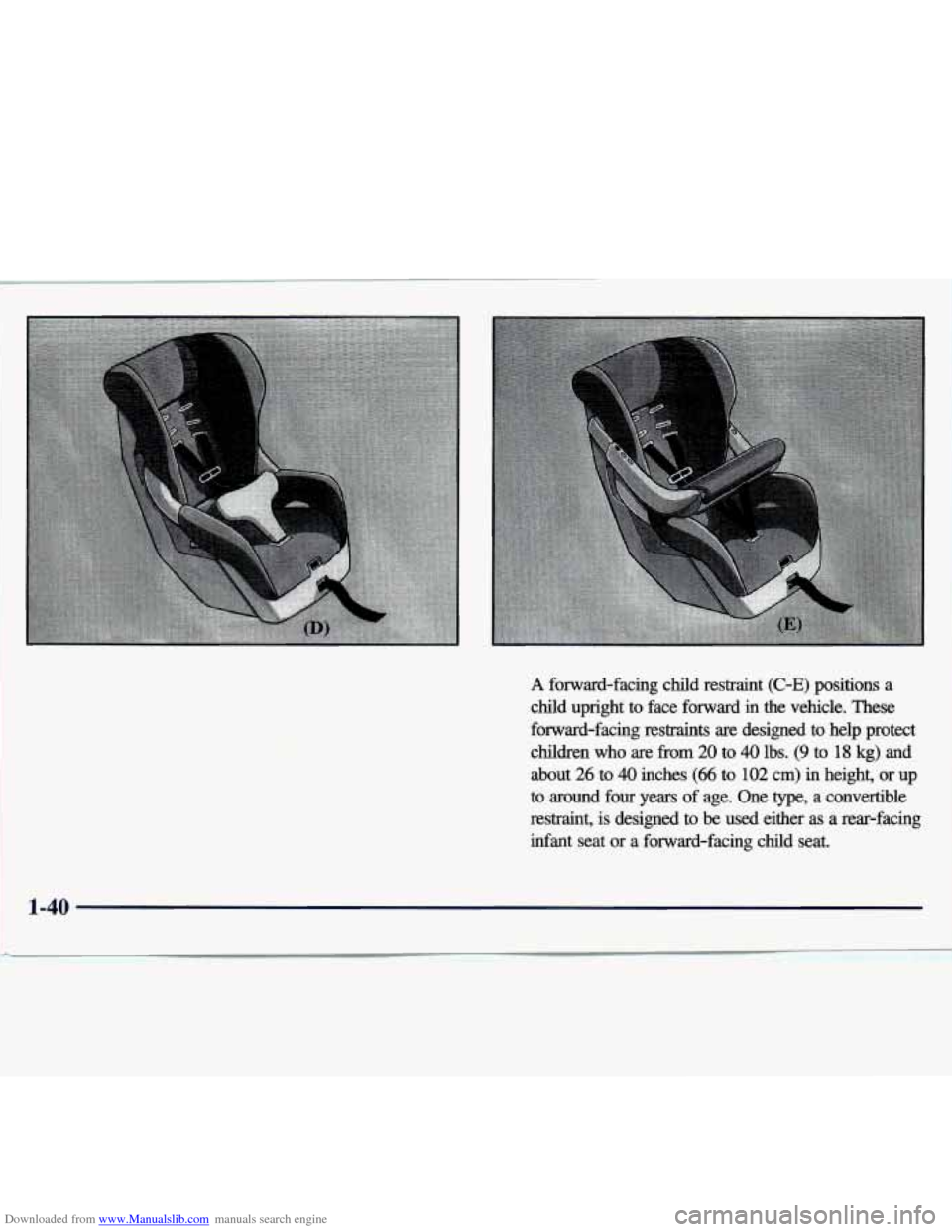
Downloaded from www.Manualslib.com manuals search engine A forward-facing child restraint (C-E) positions a
child upright to face forward in the vehicle. These
forward-facing restraints are designed to help protect
children who are from
20 to 40 lbs. (9 to 18 kg) and
about
26 to 40 inches (66 to 102 cm) in height, or up
to around four years of age. One type, a convertible
restraint, is designed to
be used either as a rear-facing
infant seat or a forward-facing child seat.
1-40
Page 269 of 386
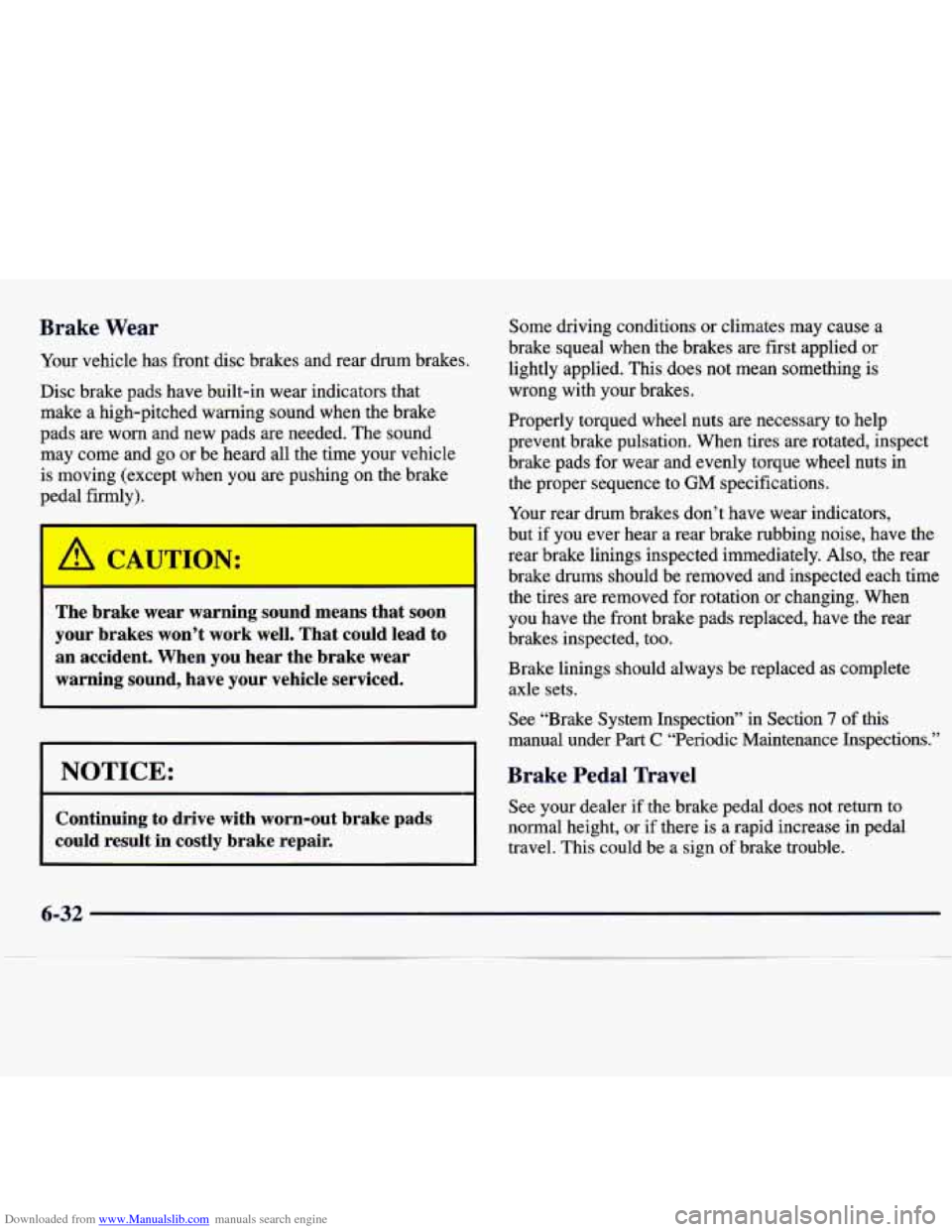
Downloaded from www.Manualslib.com manuals search engine Brake Wear
Your vehicle has front disc brakes and rear drum brakes.
Disc brake pads have built-in wear indicators that
make a high-pitched warning sound when the brake
pads are worn and new pads are needed. The sound
may come and go or be heard all the time your vehicle
is moving (except when you are pushing on the brake
pedal firmly).
The brake wear warning sound means that soon
your brakes won’t work well. That could lead to
an accident. When you hear the brake wear
warning sound, have your vehicle serviced.
NOTICE:
Continuing to drive with worn-out brake pads
could result in costly brake repair.
Some driving conditions or climates may cause a
brake squeal when the brakes are first applied
or
lightly applied. This does not mean something is
wrong with your brakes.
Properly torqued wheel nuts are necessary to help
prevent brake pulsation. When tires are rotated, inspect
brake pads for wear and evenly torque wheel nuts in
the proper sequence to
GM specifications.
Your rear drum brakes don’t have wear indicators,
but if you ever hear a rear brake rubbing noise, have the
rear brake linings inspected immediately. Also, the rear
brake drums should be removed and inspected each time
the tires are removed for rotation or changing. When
you have the front brake pads replaced, have the rear
brakes inspected, too.
Brake linings should always be replaced as complete
axle sets.
See “Brake System Inspection” in Section
7 of this
manual under Part C “Periodic Maintenance Inspections.”
Brake Pedal Travel
See your dealer if the brake pedal does not return to
normal height, or if there is a rapid increase in pedal
travel. This could be a sign
of brake trouble.
6-32
Page 284 of 386
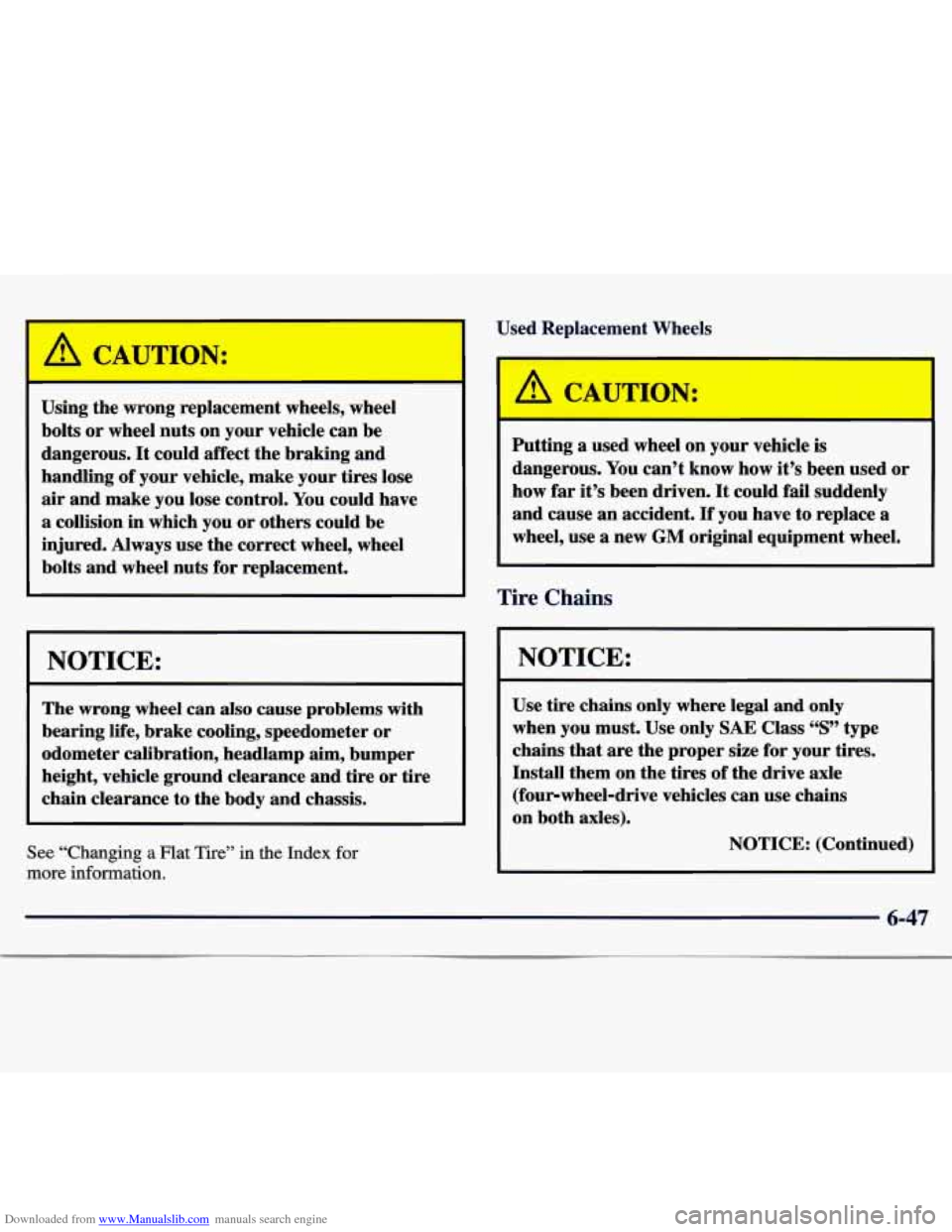
Downloaded from www.Manualslib.com manuals search engine ,A CAUTION:
Using the wrong replacement wheels, wheel
bolts or wheel nuts on your vehicle can be
dangerous. It could affect the braking and
handling of your vehicle, make your tires lose
air and make you lose control. You could have
a collision in which you or others could be
injured. Always use the correct wheel, wheel
bolts and wheel nuts for replacement.
NOTICE:
The wrong wheel can also cause problems with
bearing
life, brake cooling, speedometer or
odometer calibration, headlamp aim, bumper
height, vehicle ground clearance and
tire or tire
chain clearance to the body and chassis.
See “Changing a Flat Tire” in the Index for
more information.
Used Replacement Wheels
L A CAUTION:
Putting a used wheel on your vehicle is
dangerous. You can’t know how it’s been used
or
how far it’s been driven. It could fail suddenly
and cause an accident.
If you have to replace a
wheel, use a new GM original equipment wheel.
Tire Chains
NOTICE:
Use tire chains only where legal and only
when you must. Use only SAE Class “S” type
chains that are the proper size for your tires.
Install them on the tires of the drive axle
(four-wheel-drive vehicles can use chains
on both axles).
NOTICE: (Continued)
6-47
Page 300 of 386
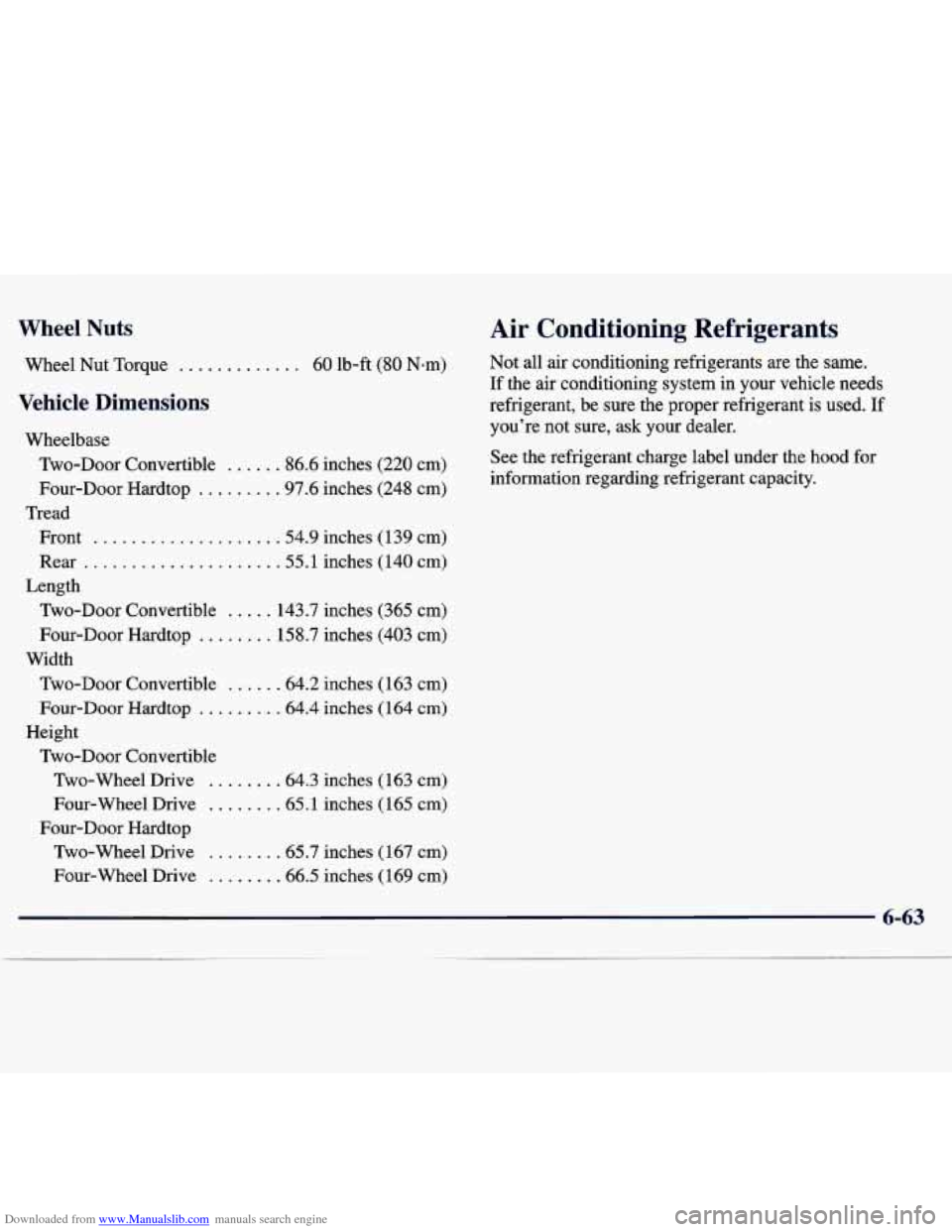
Downloaded from www.Manualslib.com manuals search engine Wheel Nuts
Wheel Nut Torque ............. 60 lb-ft (80 N-m)
Vehicle Dimensions
Wheelbase Two-Door Convertible
..... -86.6 inches (220 cm)
Four-Door Hardtop
........ .97.6 inches (248 cm)
Tread Front
................... -54.9 inches (1 39 cm)
Rear
.................... .55.1 inches (140 cm)
Two-Door Convertible
..... 143.7 inches (365 cm)
Length
Four-Door Hardtop
........ 158.7 inches (403 cm)
Two-Door Convertible
..... -64.2 inches (163 cm)
Width
Four-Door
Hardtop ........ -64.4 inches (164 cm)
Two-Door Convertible
Height
Two-Wheel Drive
....... .64.3 inches (163 cm)
Four-wheel Drive
....... -65.1 inches (165 cm)
Four-Door Hardtop Two-Wheel Drive
....... .65.7 inches (167 cm)
Four- Wheel Drive
....... .66.5 inches ( 169 cm)
Air Conditioning Refrigerants
Not all air conditioning refrigerants are the same.
If the air conditioning system in your vehicle needs
refrigerant, be sure the proper refrigerant
is used. If
you’re not sure, ask your dealer.
See the refrigerant charge label under the hood for
information regarding refrigerant capacity.